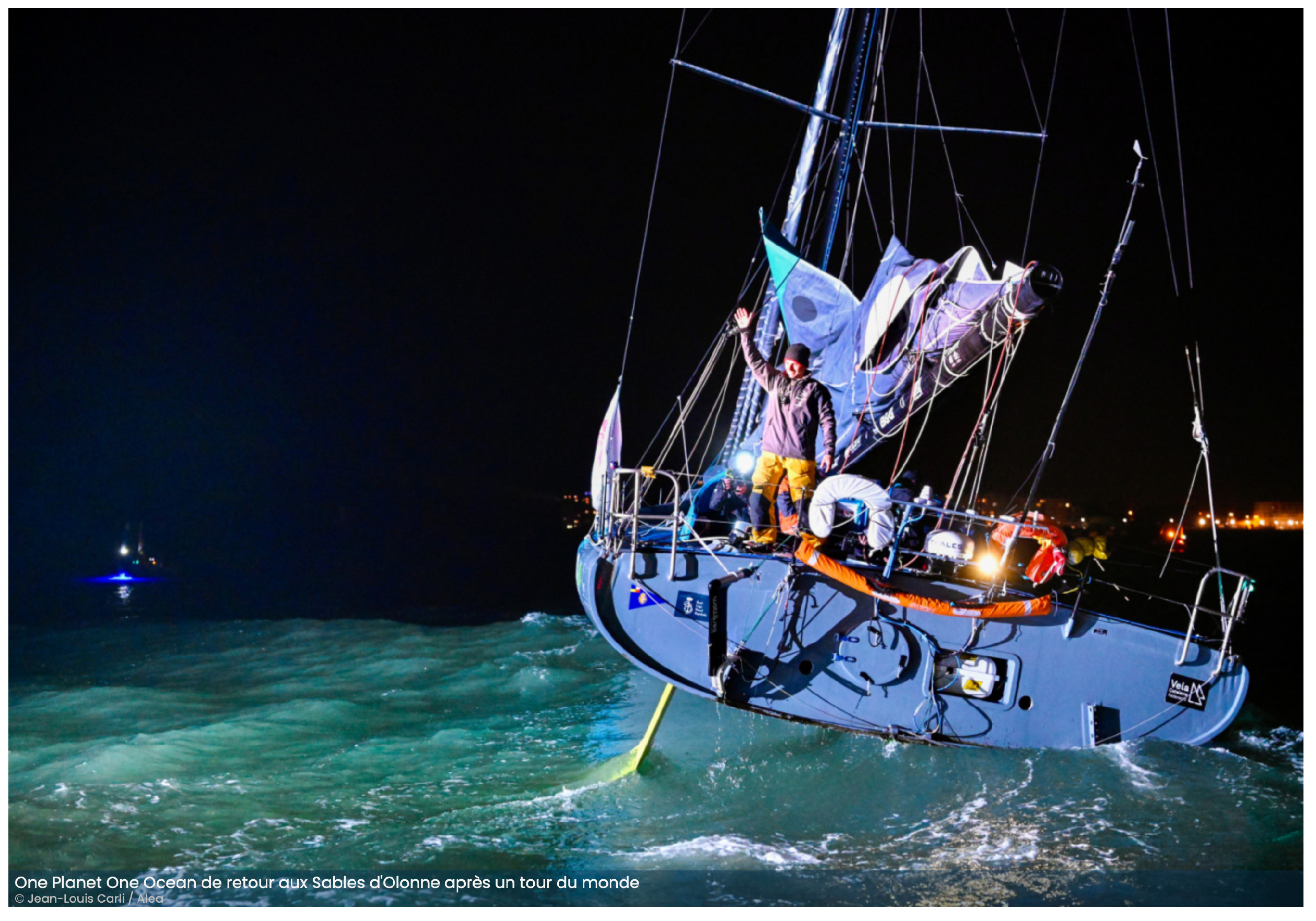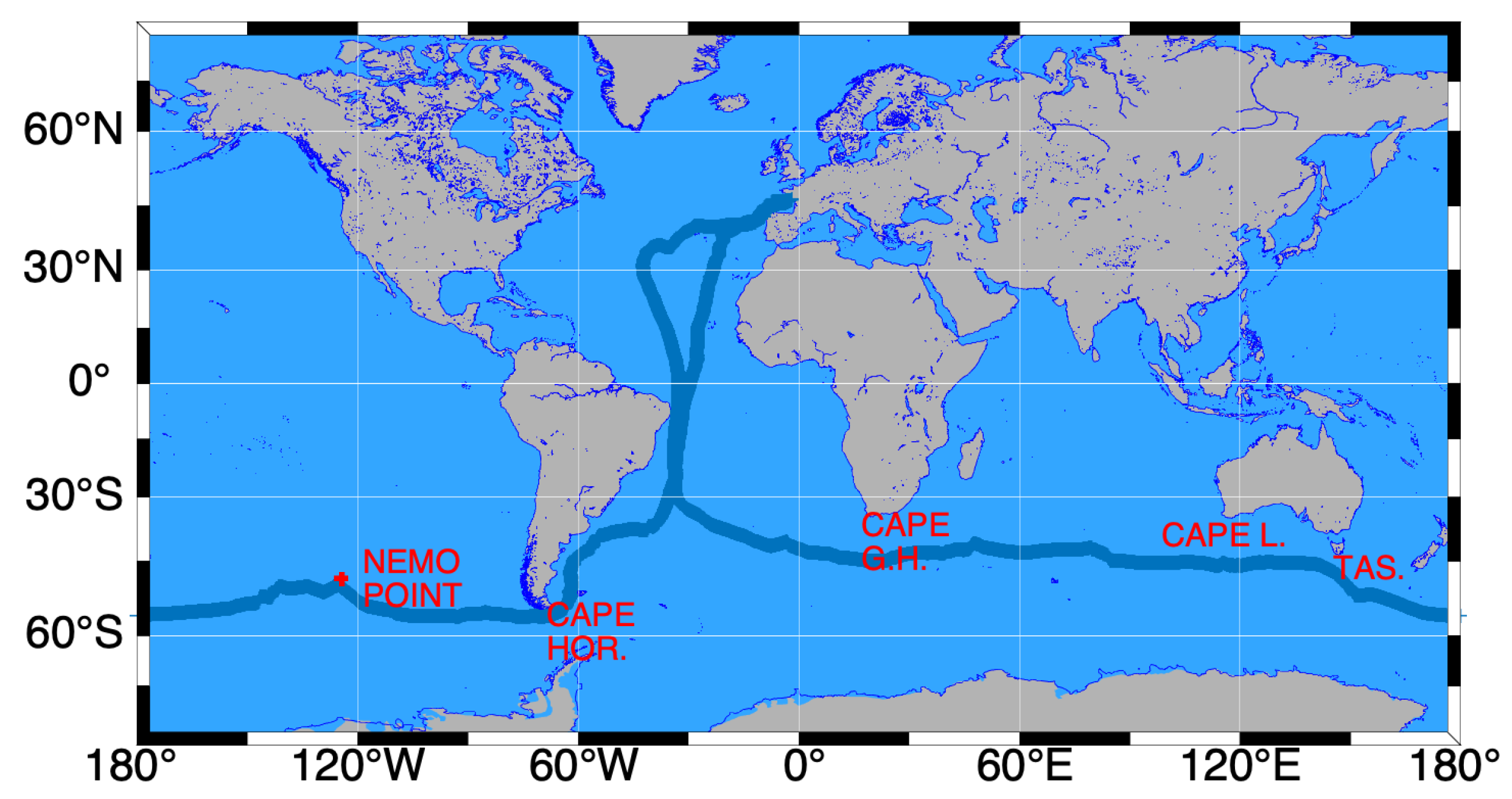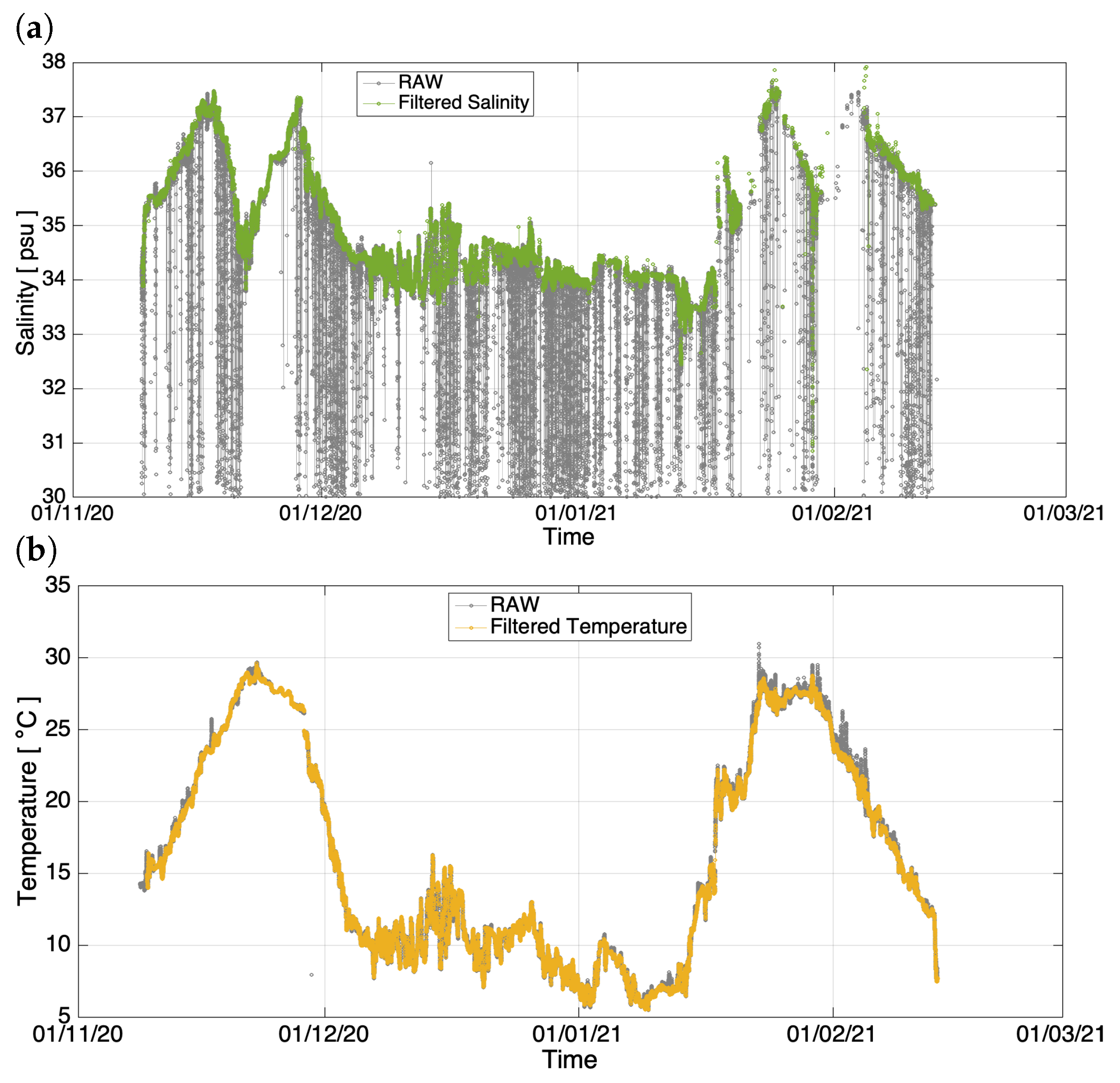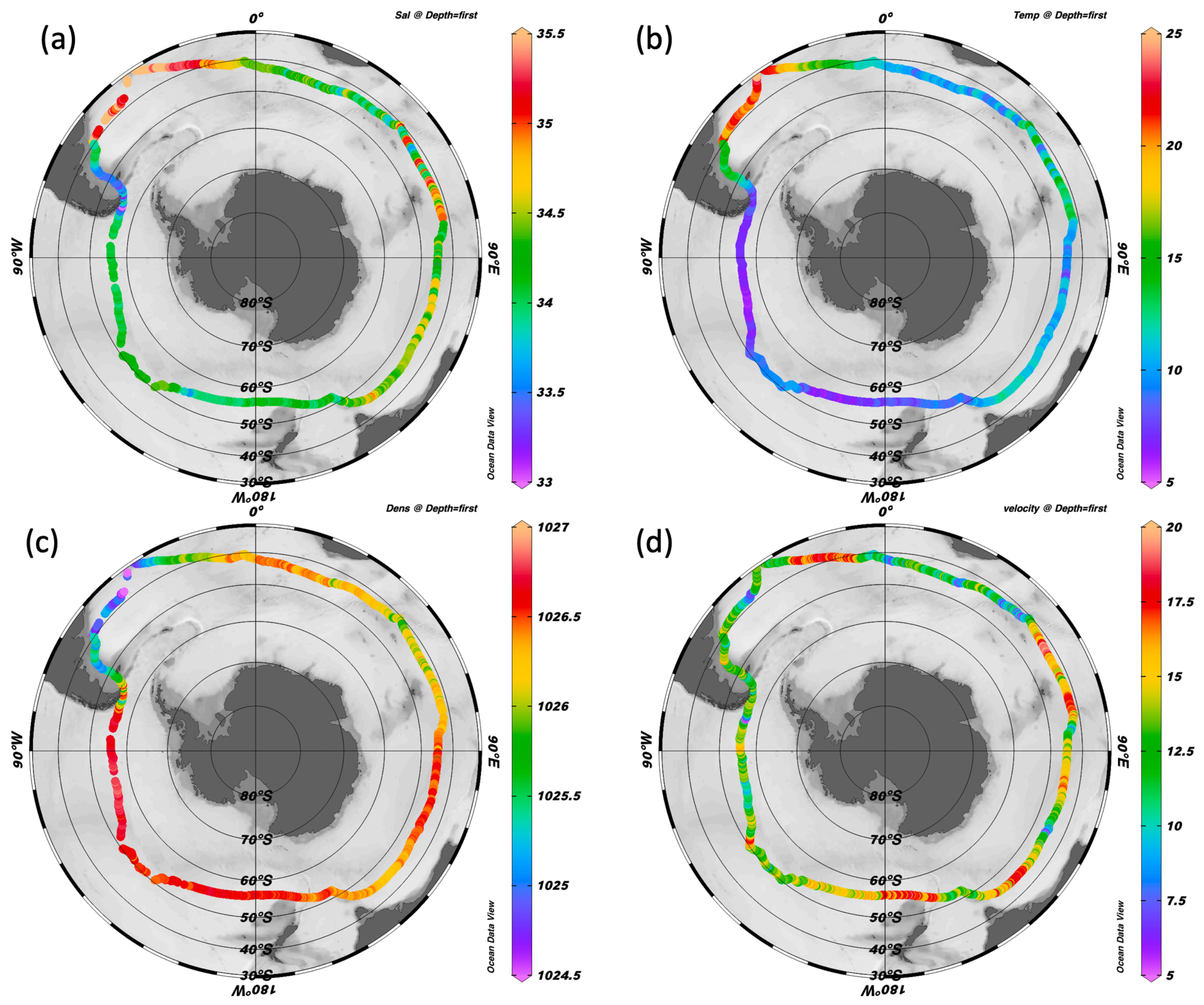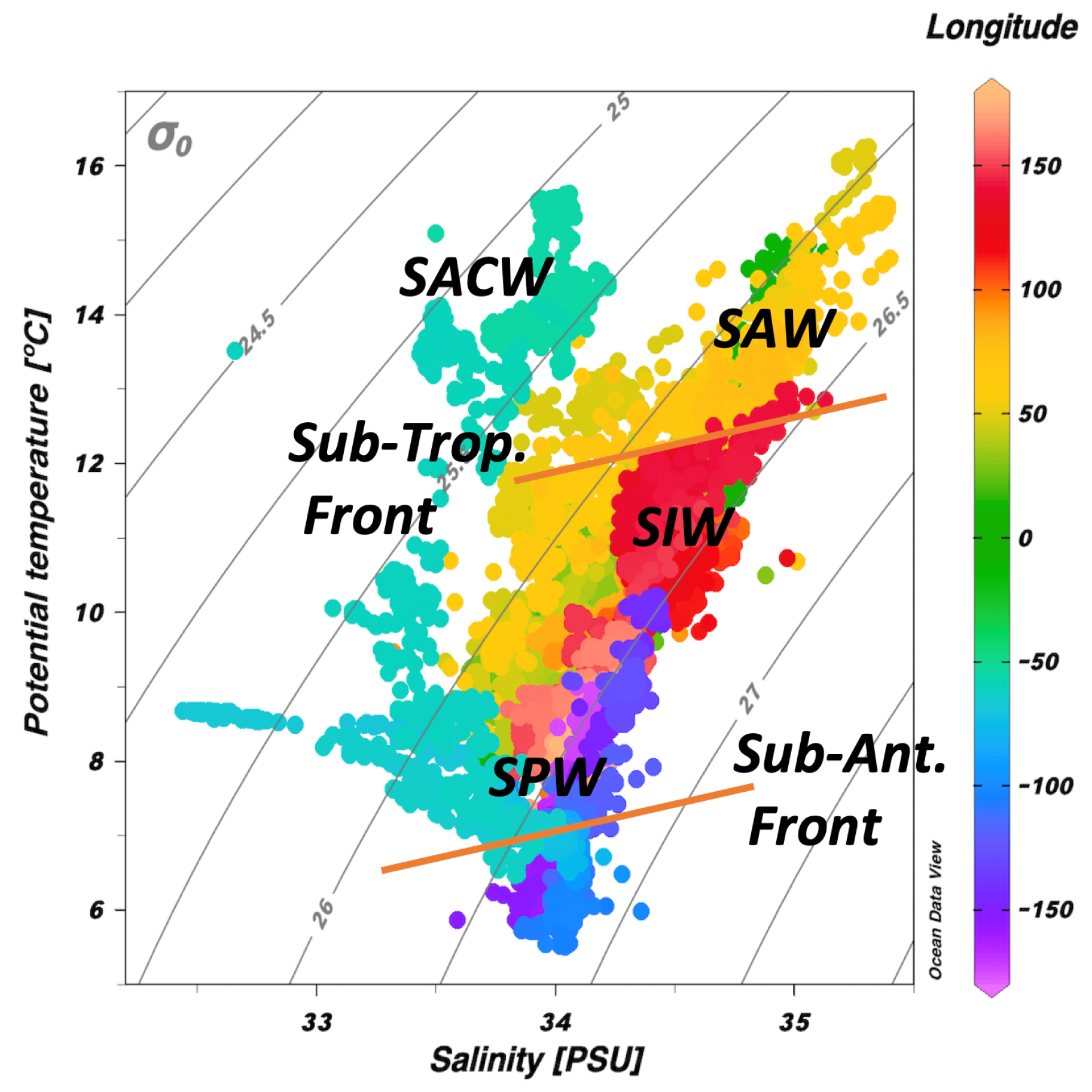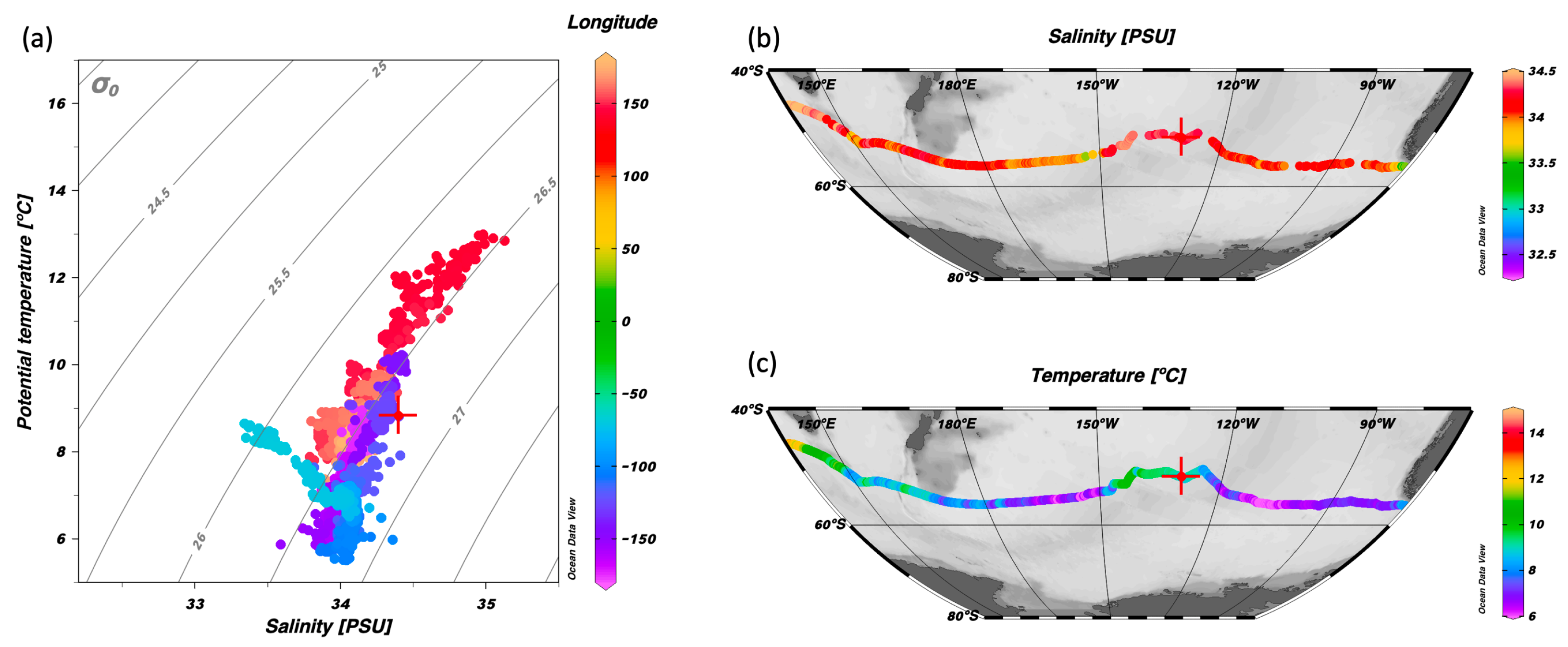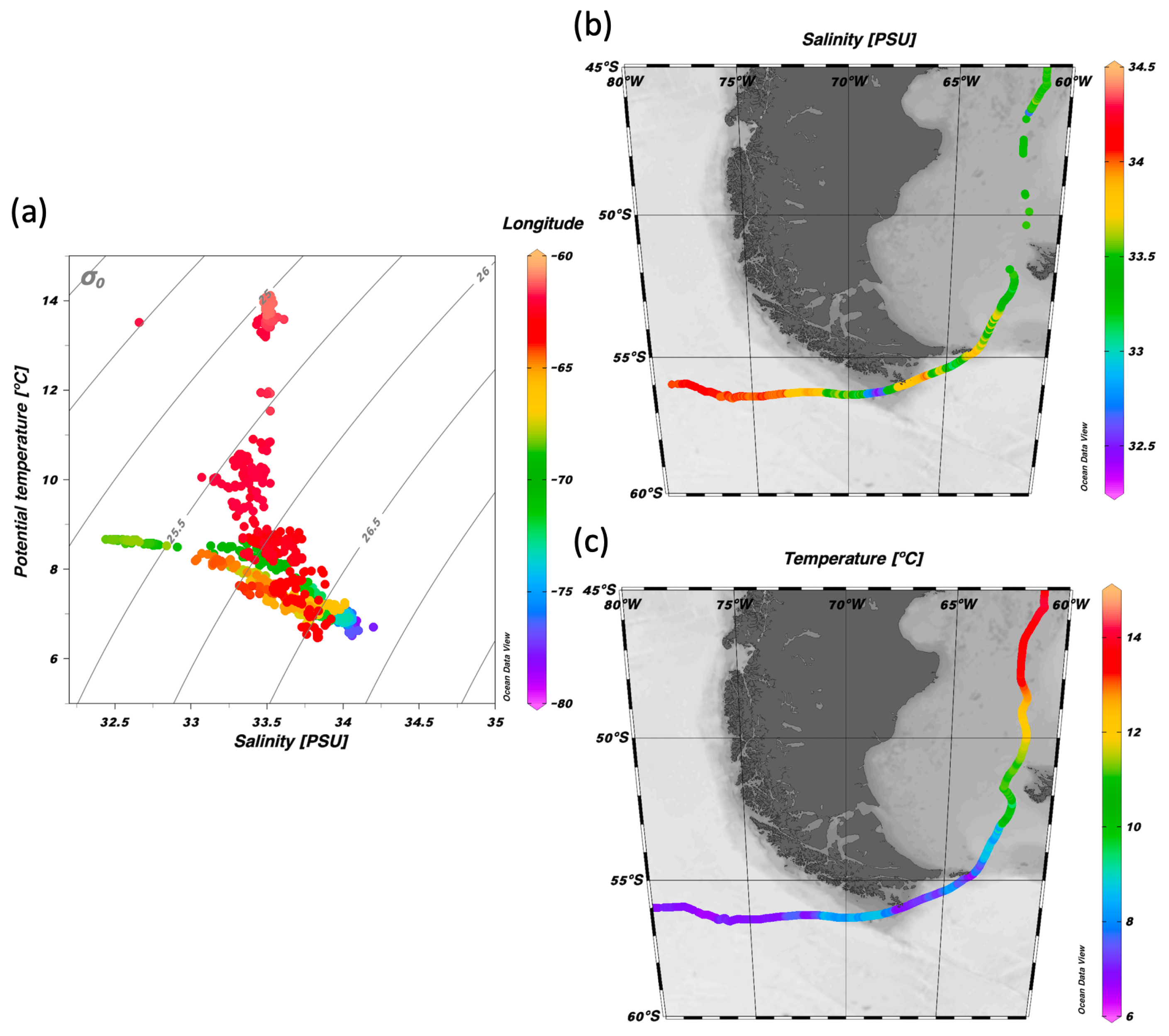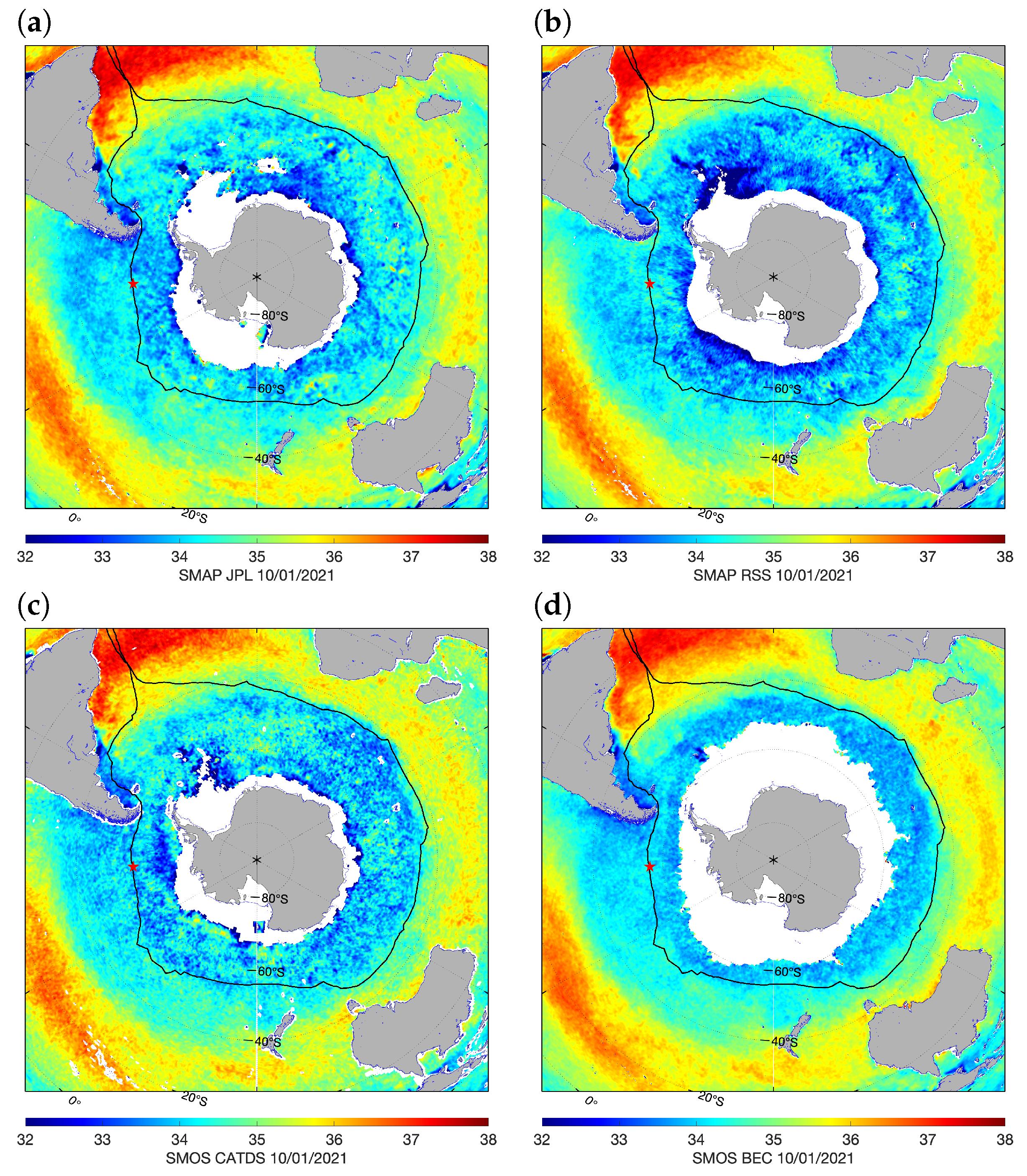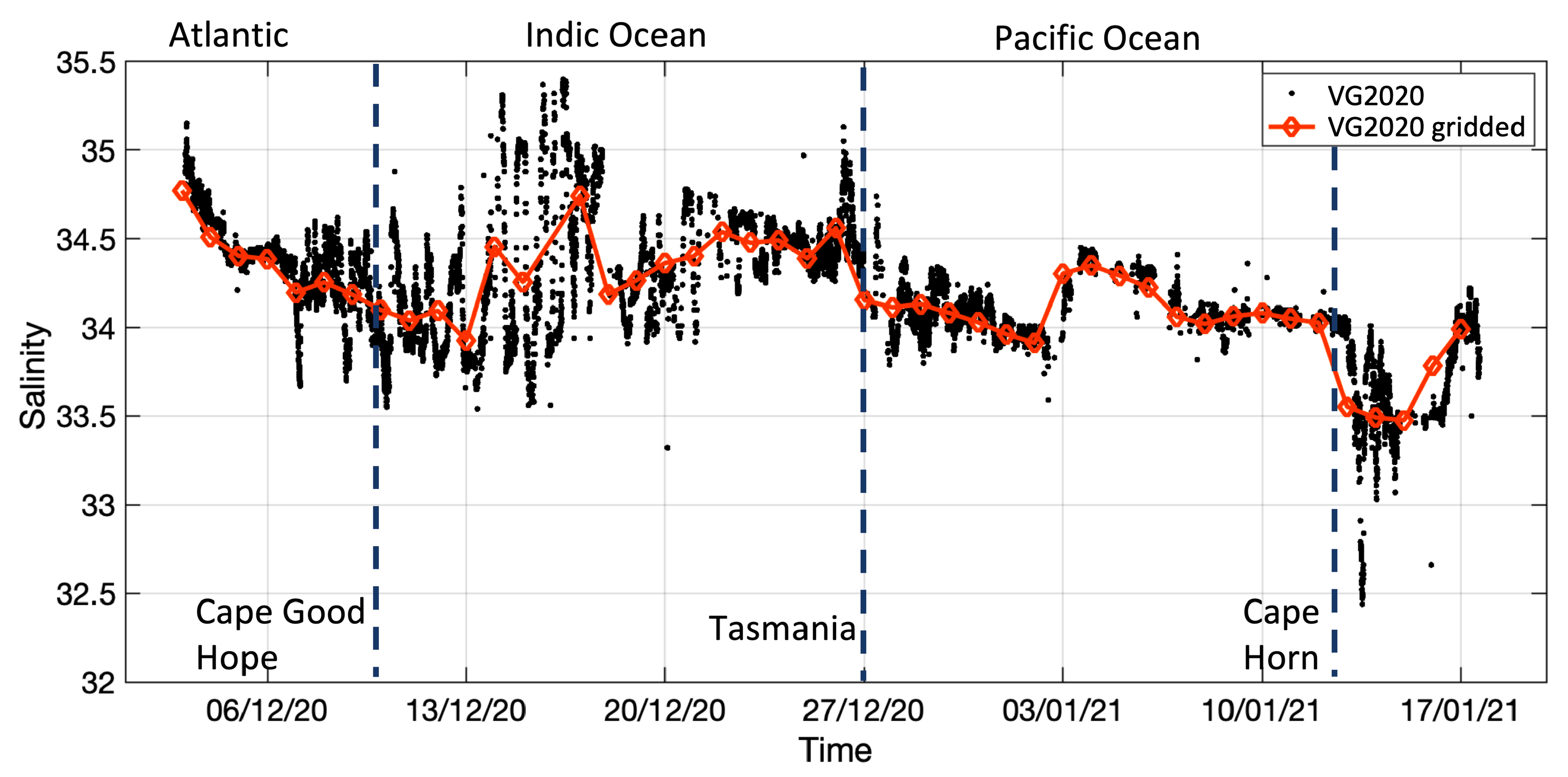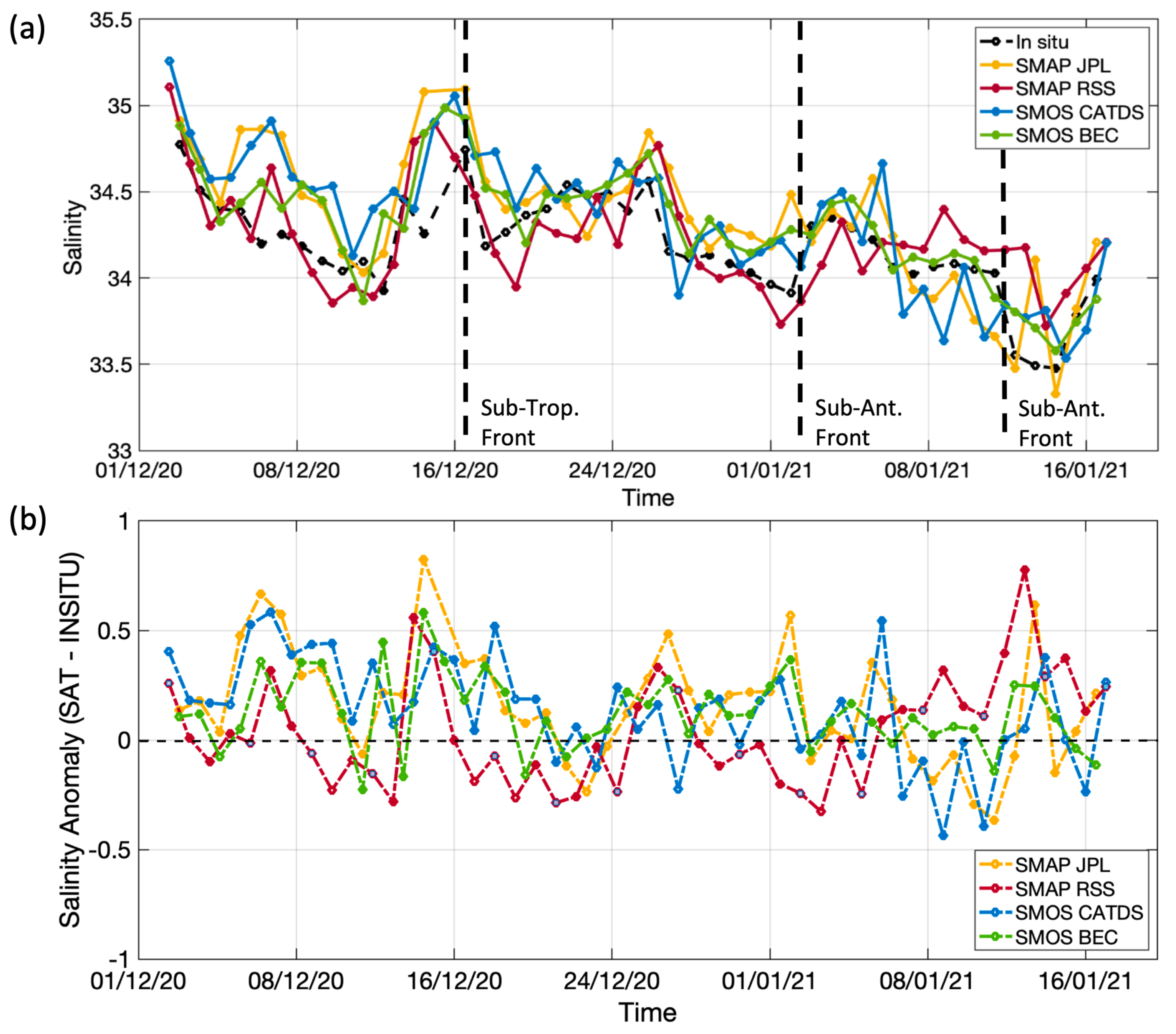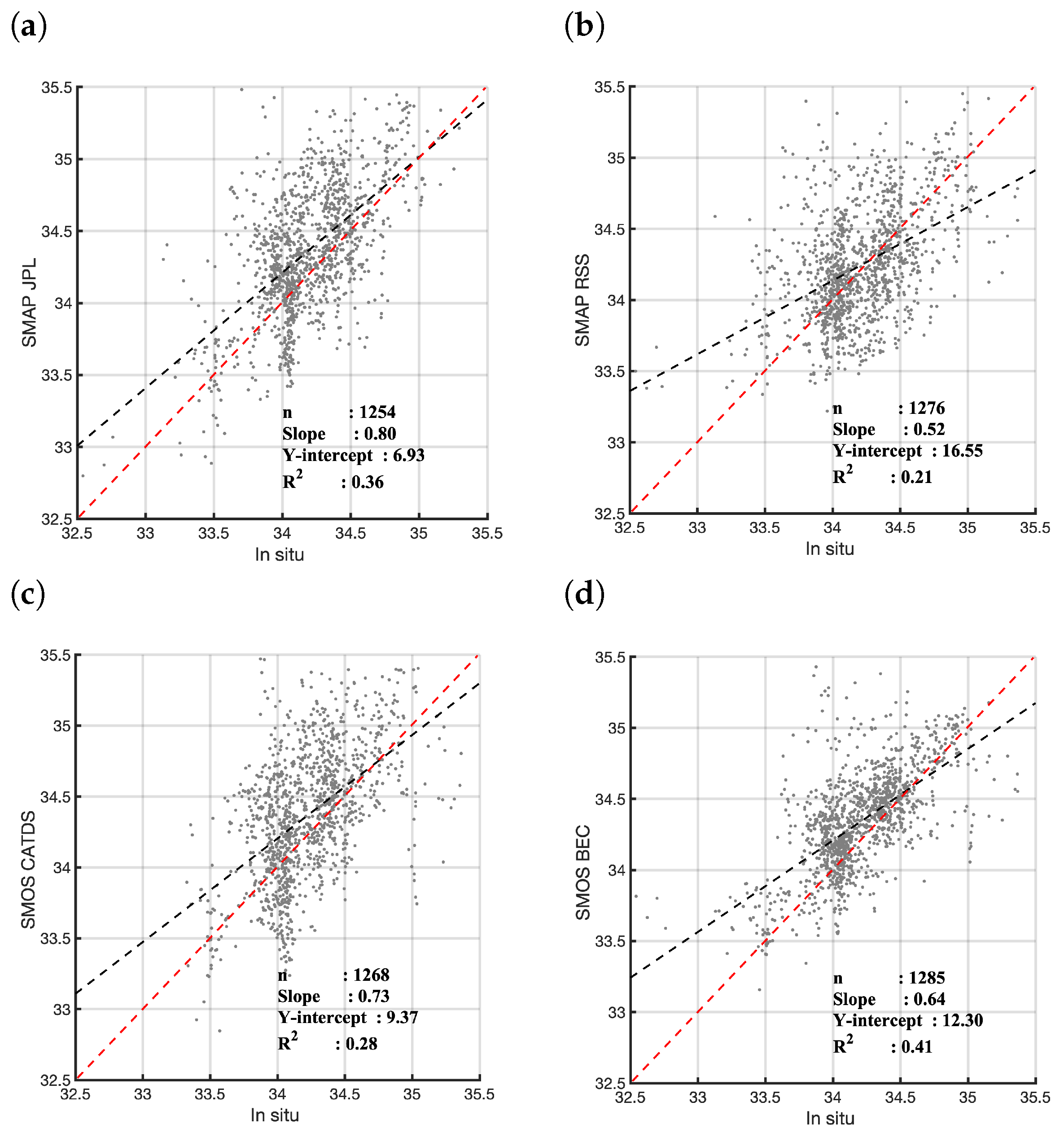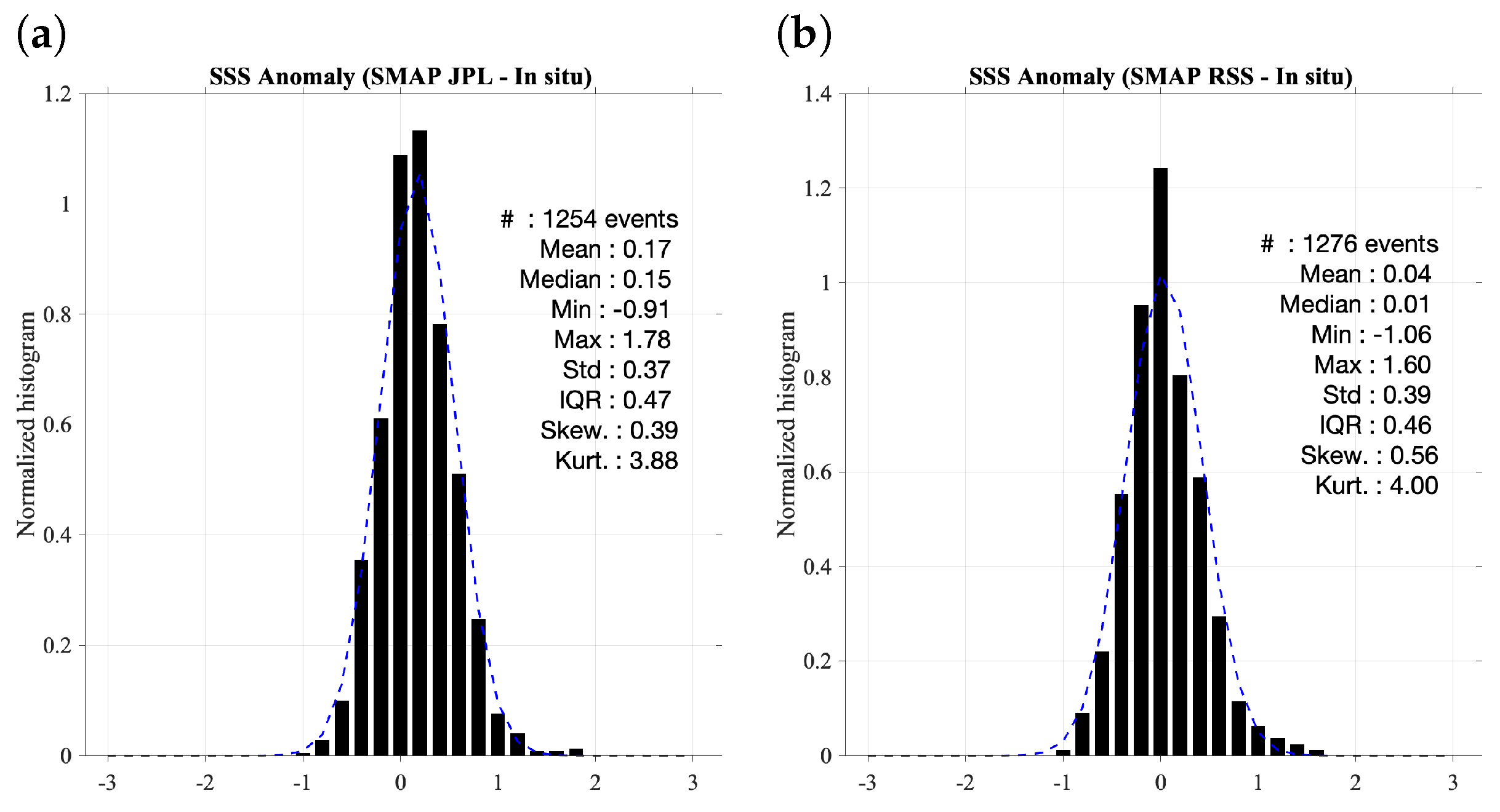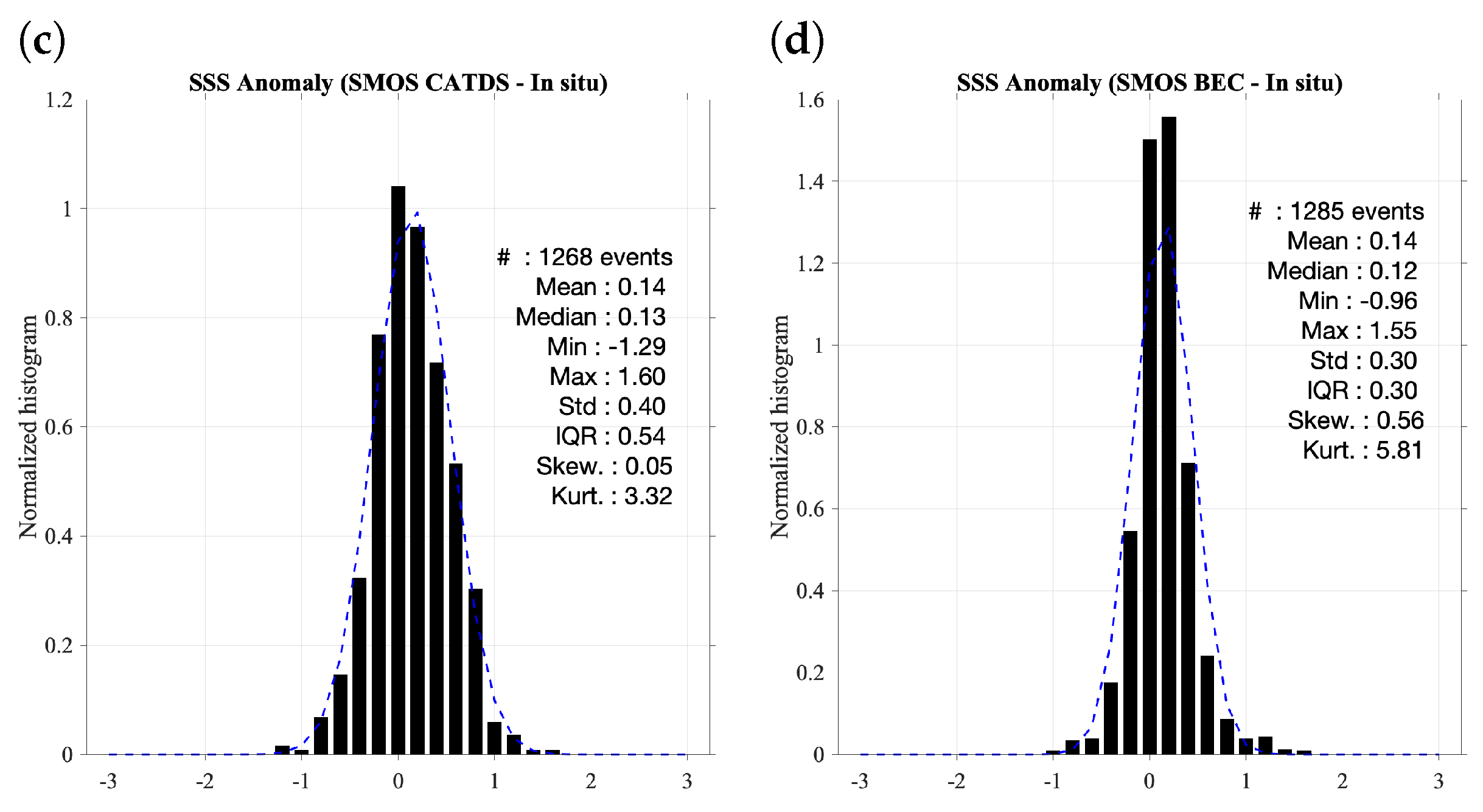1. Introduction
Sea Surface Salinity (SSS) is an important factor for understanding the ocean-ice-atmosphere interactions in the Southern Ocean, an area characterized by high winds, strong currents, the presence of fronts and under the influences of ice melting. For instance, the analysis of SSS allows us to monitor changes in sea ice distribution and concentration. The SSS anomalies are linked to sea ice production and water evaporation (positive SSS anomalies) and to melting and precipitation (negative SSS anomalies). Because of the distance and adverse weather conditions, acquiring in-situ salinity measurements in the sub-Antarctic zone is extremely difficult. As a result, satellite observations become a promising option for having continuous and synoptic monitoring of SSS in polar regions.
Since 2009, a new generation of satellites (SMOS from ESA and, later, Aquarius and SMAP from NASA) have provided radiometric measurements in L-band, allowing us to retrieve SSS. In Southern Ocean there are several aspects that hampers the SSS retrieval from L-band measurements. The reduction in sensitivity of brightness temperatures to SSS in cold seas degrades the accuracy of the SSS retrieval in polar regions. Moreover, L-band measurements are seriously affected by land–sea and ice–sea contamination effects. Recently, these difficulties have been addressed over the Arctic Ocean, leading to satellite SSS measurements with enough quality to allow scientific studies [
1,
2,
3,
4,
5]. However, in the Southern Ocean, SSS has lower variability range than in the Arctic Ocean, and roughness corrections mandatory to retrieve SSS are very challenging due to complex wind–current–wave interactions. Therefore having in-situ data as a ground truth is crucial for validating and enhancing the quality of satellite products in this region. Argo floats are usually used to validate SSS products, however the depth where Argo floats measure salinity is much deeper than the depth where the satellites observe salinity. The difference brings some biases, especially close to the coastal regions where much freshwater is supplied [
6,
7].
In 2010, the Barcelona World Race (BWR) organizers, scientists from the Institute of Marine Sciences (ICM-CSIC), and members of the Maritime Catalan Forum (FMC) agreed to equip one sailing boat participating in the BWR with a MicroCAT temperature and conductivity sensor, as well as an XCAT transmitter. The objective was to investigate if oceanic races could be used to measure global surface temperature and salinity in real time without interfering with navigation or penalizing the boats’ race performance. Continuous surface monitoring was carried out for the first time during a round trip around the world’s oceans in less than 4 months, contributing to a global study of ocean surface properties and were used to validate remotely sensed salinity products. This was of particular interest because the vessel’s route included rarely sampled regions in the Southern Ocean [
8]. After this successful first experience, the collaboration continued, allowing us to collect surface data of conductivity and temperature in the following competitions [
9]. In this study we present a new data set, collected in the 2020–2021 Vendée Globe edition.
The Vendée Globe race follows a Clipper route circumnavigation, the fastest circumnavigation of the world. Taking advantage of the strong westerly winds of the Roaring Forties, the route runs from west to east through the Southern Ocean. The Vendée Globe is called after the Vendée département in France, where the event starts and finishes at Les Sables-d’Olonne. From Les Sables d’Olonne, participants onboard IMOCA 60 vessels (a monohull 18 m sailing yacht) navigate the Atlantic Ocean to the Cape of Good Hope; then clockwise around Antarctica, keeping Cape Leeuwin and Cape Horn to port; and finally returning to Les Sables d’Olonne crossing all Atlantic Ocean. The race usually lasts around 24,000 nautical miles (around 44,000 km) and takes place from November to February, aiming to sail through the Southern Ocean during the austral summer. The Vendée Globe is recognized as the greatest endeavour in ocean racing and an extreme challenge of individual endurance. The race presents significant difficulties, such as the strong wind and wave conditions in the Southern Ocean, the competition’s lengthy unassisted duration, and the fact that the route takes racers far from any regular emergency service.
The 2020–2021 Vendée Globe was the ninth edition of the race. It started on 8 November 2020, with the first finishers arriving on 27 January 2021, and last boat arriving on 5 March 2021. There were a total of six female participants among the 33 starters and 25 finishers, which was a record high. The Spanish skipper Dídac Costa completed the race on board of the One Planet Ocean which sailed 24,500 nautical miles in 97 days, 6 h, 27 min and 3 s (
Figure 1).
South of 40
° S, the Vendée Globe route runs almost parallel to the Antarctic Circumpolar Current (ACC), the world’s largest current, that flows eastward around the Antarctic continent, moving between 100 and 173 Sv [
10,
11]. The ACC is part of the Meridional Overturning Circulation, which ventilates the Pacific, Atlantic, and Indian Oceans’ deep basins. Between the ACC’s southern edge and the Subtropical Front to the north, three major fronts can be identified: the Southern ACC Front, the Polar Front, and the Sub-Antarctic Front in some places [
12,
13,
14]. The Vendée Globe route crosses the Subtropical front, and the Sub-Antarctic Fronts, where few in-situ data are available.
The first objective of this study is to present a new set of in-situ data (later named as VG2020) obtained thanks to the collaboration between ICM, FNOB and with Vendée Globe organizers. On the other hand, we use this in-situ data to validate the current available remote sensed SSS products from SMOS and SMAP satellites in the sub-Antarctic zone, where few in-situ data are available.
2. Data and Methods
2.1. Vendée Globe In-Situ Data
The Vendée Globe edition 2020–2021 (VG2020) in-situ data have been measured by using a Seabird SBE 37-SI MicroCAT installed in the sailing boat. The SBE 37-SI MicroCAT is a high-accuracy conductivity and temperature sensor equipped with a memory to save the data acquired. Externally powered, the MicroCAT is useful as a stand-alone monitoring device. The conductivity sensor has an accuracy of ±0.0003 S/m (0.003 mS/cm), a resolution of 0.00001 S/m (0.0001 mS/cm) and a stability of 0.0003 S/m (0.003 mS/cm) per month. The temperature sensor has an accuracy of ±0.002 °C (−5 to to 35 °C); ±0.01 °C (35 °C to 45 °C), a resolution of 0.0001 °C and an stability of 0.0002 °C per month. The sensor was calibrated in the factory just before the race started, in September 2020, and installed on the ship in October 2020. The instrument was connected to the ship’s 24 volts batteries through a voltage regulator (7812 with TO220 capsule) so that the input voltage to the sensor remains always constant at 12 volts. This protects the sensor from power overloads. The sensor was installed and configured to autonomously record and store conductivity, temperature and timestamp with a frequency of one measurement every 30 s (two per minute). It has a temperature-compensated crystal oscillator (TCXO, 32,768 Hz) as a real-time-clock frequency source whose accuracy is ±1 min per year (0 °C to 40 °C). In this way timestamp of the data stored can be merged with the ship’s GPS clock to retrieve the position and date of every sample. Once uninstalled after the race, the sensor has been checked in the laboratory to confirm the absence of possible drifts. Therefore no drift corrections were applied to the data.
The positions along the trajectory (
Figure 2) where measured using a GPS installed in the boat. The sensor was installed inside the articulated keel which stabilized the boat (
Figure 3). It was fixed in this space by means of two flanges anchored in the hull. In this way, the sensor remains nearly at 60 cm bellow the surface, stays in full contact with continuously renewed water. However, the sensor may be impacted by foam if the boat is sailing with the hull too close to the surface, during storm episodes, or when the boat sails too fast. In those cases, data can be affected by as the presence of bubbles that reduce the area of the conductivity sensor, underestimating the conductivity.
2.2. Vendée Globe Data Filtering Process
The data obtained along the race course need specific assessment as they were measured with a non specialized oceanographic boat. As explained above, the sensor is located in the hull, therefore, the measurements are directly impacted by vessel speed conditions. Temperature (T) and conductivity (C), which are highly linked variables, are the sensor’s primary data.
The filtering process applied to the data is the following:
Checking that temperature and salinity are within a geophysical values range. Temperature is filtered out when there are values outside the range of (0–35 °C), and conductivity when the resulting salinity lies outside the range of (30–40 psu). These filtered measurements include records obtained when sensor box was outside the water;
The temperature measurement is flagged when (a) there are short spikes denoting that the water might be stagnant, (b) when there are significant differences from the surrounding values and in the absence of strong temperature gradients.
Once the temperature record is considered acceptable, we then flag conductivity when (a) trends are significant opposite to those of temperature and (b) when producing salinity spikes, as detailed bellow. When only conductivity is flagged we considered that the temperature is good and salinity bad. As mentioned above, data are filtered when the local trends of T and C are opposite. In some cases, the water in the box is not renovated, causing an increase (or decrease) in the temperature and conductivity values that are not corresponding to the sea water crossed by the sailboat. If the water container gets stagnant, T rapidly rises (or decreases) and recovers once the water is replaced again. Moreover, under high-hull-speed conditions, the rise of the hull above the water causes air bubbles and foam getting the sensor box, and even empty the sensor box. Bubbles or foam only influence conductivity. These episodes of bubbles and foam entering the sensor box are typically related to the boat’s heading in relation to the wind direction. A lot of foam may come under upwind sailing (i.e., wind blowing 45 to 90 degrees off the heading) especially under rough seas. A downwind sailing may rise the boat over the water, causing the sensor box to dry up. Under crosswind sailing, typically no foam enters the sensor box as boat is attached to the water, and is moving quickly.
A comparison of filtered and original measurements are shown in
Figure 4. Abrupt peaks in temperature associated to situations of stagnation of the sensor are removed. Most of the salinity measurements affected by bubbles (abrupt decreases of salinity values) are filtered out. Note that, close to the equator, when the boat was coming back to France at the end of January 2021, the measurements exhibit a decrease in salinity that coincided with an increase in temperature that may reflect the effect of a heavy tropical rain.
2.3. Remotely Sensed SSS Products
We use four different Level-3 SSS products. Two are derived from the Soil Moisture and Ocean Salinity (SMOS) ESA mission and two from the Soil Moisture Active Passive (SMAP) NASA mission. SMAP JPL v5 and SMAP RSS v4 correspond to 8-day running mean maps on 0.25 degree resolution grids provided by the Jet Propulsion Laboratory [
15] and Remote Sensing Systems [
16], respectively. SMOS BEC v2 and SMOS CATDS v5 are 9-day running mean product at 0.25 degree and 25 km resolutions respectively obtained from the Barcelona Expert Center on Remote Sensing of the ICM-CSIC [
17] and the LOCEAN/IPSL (UMR CNRS/UPMC/IRD/MNHN) laboratory [
18]. We have regridded all datasets to a common 0.25
° regular grid. Each dataset was accessed on 20 January 2022 from the following links:
https://doi.org/10.5067/SMP50-3TPCS,
https://doi.org/10.5067/SMP40-3SPCS,
http://dx.doi.org/10.20350/digitalCSIC/12601 and
https://doi.org/10.17882/52804.
4. Conclusions
The in-situ data obtained with the One Ocean One Planet boat competing in the Vendée Globe race are presented in this study. Results show that reliable data can be obtained for scientific purposes using vessels competing in round-the-world regattas. The data were thoroughly filtered and used to identify the typical sub-Antarctic oceanic features. Signatures of melting-affected regions, as well as sub-tropical and sub-polar fronts, were clearly recognized. Even if some parts of the race vessel measurements exhibit foam and air particle effects that must be filtered, they still represent a source of real surface information that is extremely beneficial as a sea-truth reference as well as for climatological studies.
For instance, this new data collection proves to be of great use for the validation of L-band SSS products in the Southern Ocean using ESA and NASA SSS missions. Because the race route includes infrequently sampled locations, the data gathered by One Ocean One Planet are very relevant for the validation of remotely sensed products. This provides significant insight into the assessment of the satellite SSS products since satellite data are typically validated using Argo data, despite the fact that their shallowest observations are between 2 and 10 m depth, which may overlook surface features observed by satellites. The values obtained with the One Ocean One Planet boat are much shallower (60 cm depth) which is closer to satellite observations than the Argo data.
The present contribution to ocean surface salinity data gathered within the Vendée Globe has been successfully used to validate satellite SSS products for the Southern Ocean, provided by ESA and NASA SSS missions. During the period that the regatta sailed south of 40S (3 December 2020–18 January 2021), the satellite products revealed average differences of 0.01–0.15 psu and a range of 0.3–0.4 psu standard deviation with respect to satellite observations.
These results are a step forward to analyzing the evolution of ocean salinity in sub-Antarctic zones and the impact of changes in the ice extent around Antarctica. Having periodic in-situ measurements in the sub Antarctic zone should allow us to analyze the impacts of the ice extent changes in the Antarctica and in the sub Antarctic zone. The study reveals the interest in data recording efforts through competing boats in the periodic round world races to contribute to ocean scientific knowledge. This novel research proves that the regatta’s various vessels competing in Vendée Globe race every four years can be equipped for research in the future.
